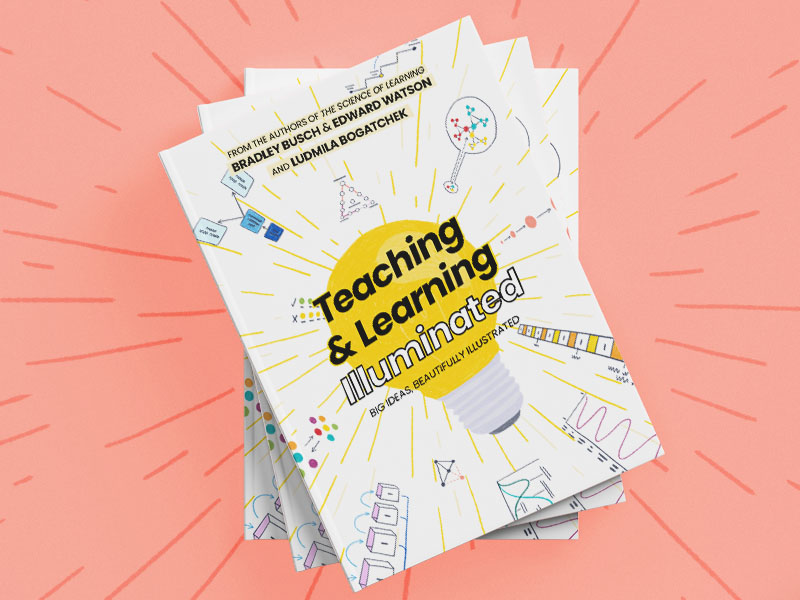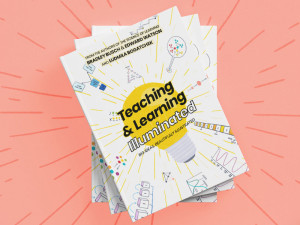
The Good News: research into cognitive science can be SPECTACULARLY USEFUL to teachers. (That’s why we have Learning and the Brain conferences….)
The Less Good News: ideas that come from cognitive science can be MISUNDERSTOOD and MISAPPLIED with alarming frequency.
For example: as I’ve written elsewhere, dual coding has lots of potential benefits for reducing working memory load — and thereby helping students learn. That’s the good news.
But — less good news — dual coding has too often been interpreted to mean “put icons on things to make them better.”
Wouldn’t it be great if someone could bring together LOTS of ideas from cognitive science, AND explain them with well-executed dual coding?
Yes; Yes It Would…
Well, someone has done exactly that. Three someones, in fact. Bradley Busch, Edward Watson (no relation), and Ludmila Bogatchek have written Teaching and Learning Illuminated: the Big Ideas, Illustrated.
As that title promises, this book illuminates (that is, dual codes) the greatest hits from cognitive science: retrieval practice, cognitive load theory, Rosenshine’s principles, mindset, and a few dozen more.
Each section combines a pithy description of a particular concept with a visual representation of its core ideas.
So, for instance, page 35 summarizes dozens of studies looking at the benefits of spreading practice out (“spacing”) and practicing related topics together (“interleaving”).
And, the facing page offers a carefully considered graph that depicts learning over time. One path (“cramming”) looks good because it works so well in the short term. But the second path (“spacing and interleaving”) results in more learning over time.
Voila: “desirable difficulties” in one thoughtful graph.
Unlike so many examples of dual coding of the “put-an-icon-somewhere” school, Busch, Watson, and Bogatchek create substantial, meaty visuals that both require and reward careful study.
I never looked at the illustrations and thought: “gosh, that’s pretty.”
Instead, I thought:
Oh, gosh, I need to stop and study this for a bit.
Wait, why is that line there?
Ok, now I get it. Presumably this axis is labeled…oh, right, so cool!
In other words, the visuals both require thought and support thought. The result: readers understand these complex ideas even better.
So Many Shelves
I’ve written in the past that the “best book to read” depends on the reader’s current knowledge.
If you’re somewhat of a beginner in this field. I think you should probably read a book that focuses on just one topic: long-term memeory, or attention, or cognitive load theory.
Once you understand lots of the pieces, it’s time to read the books that put them all together.
Teaching and Learning Illuminated looks like an easy read — so many cool pictures! At the same time, it includes an ENORMOUS number of research-based insights and suggestions.
For that reason, I think of it as an “early-advanced” book more than one for those who are new to the field. Those illustrations are welcoming, but they also create cognitive demands of their own.
Full Disclosure
Because this field is relatively small, I know one of the three authors — Bradley Busch — a bit. (I recently recorded some brief video snippets for his website.)
I don’t believe our conversations have influenced this review, but the reader should know of them in making that evaluation.
I’ll also note: yes, I have written a book about Mindset; and yes, this book includes a mindset chapter called “The Watson Matrix.” But: their matrix isn’t about my summation of mindset theory.





